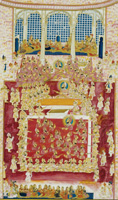home | metro silicon valley index | the arts | visual arts | review

Lent by Judy Wilbur. Photograph by Kaz Tsuruta.
Holi days: A watercolor by court painter Ghasi shows the courtly celebration of Holi.
Land of Kings
The Asian Art Museum opens palace doors in new show about Indian court art in Mewar state
By Michael S. Gant
IN A WATERCOLOR whose sense of occasion is enhanced by gold accents, visiting dignitaries partake in Holi, an Indian spring festival. The presiding potentate, Jawan Singh (who ruled 1828-1838), can be distinguished by his blue and gold halo; he appears three times in a narrative that proceeds vertically: he lights a hookah; he dispenses liquid vermillion from what looks like a large syringe; he bathes in red-dyed water with his lords. At the top of the painting, sealed off in a latticed courtyard, sit the women of the court; at the bottom, they are segregated on a rug. This official rendering of a significant political event, done by an artist named Ghasi, is alive with incident as the bearded participants crowd round, their garments splattered with vermillion. This mix of documentation and aesthetics can be seen throughout "Princes, Palaces and Passion: The Art of India's Mewar Kingdom," at the Asian Art Museum.
The show assembles a varied selection of paintings, plaques and folk arts created from the 1500s to the 1900s in the kingdom of Mewar, part of the northern Indian region known as Rajasthan and often referred to as the Land of Kings. The fabled lakeside Mewar capital of Udaipur sent early English imperialists into fits of romantic rhetoric, but the Hindu rulers of Mewar earned their local fame the hard way: by resisting the Muslim invaders for as long as possible and then negotiating a treaty on favorable terms.
Much of the art focuses on court life. An opaque watercolor from the early 1800s shows a boldly charging elephant, its mightily foreleg thrusting at the stick-bearing horseman racing ahead of it. (The catalog insists that the beasts were not to be harmed.) It is the work of Chokha, an exceptional painter given long overdue appreciation in this show. Episodes From the Life of Krishna, by Chokha and his helpers, visualizes a complex skein of events. Down either side, rectangular frames act like cutaways to show us interior scenes in the life of the god; they are separated by a river passing through two fields on which other magical events, such as Kirshna's encounters with demons and serpents, take place. A magnificent tiger strides through the action. The proper order of Krishna's life was to be explicated by a storyteller, using this painting like a visual display with power points.
The packing of paintings with multiple incidents occurs often—these are as much broadsides as artworks. An early-1700s portrait of Maharana Sangram Singh II is bordered with 14 oval insets showing incarnations of Vishnu; not so subtly, the radiant disk that frames Vishnu's head is replicated around the head of Sangram Singh II, just in case anyone doubted his connection to divine right. Another showpiece for Sangram Singh II depicts his royal party (figuratively) dropping in on a holy man. The compound of the famous ascetic is arrayed horizontally across the lower quarter of the image; the king's procession heads straight down the painting. You have to tilt your head 90 degrees to put them in proper perspective.
One intriguing example of the survival of traditional crafts is a Kavad, dated about 30 years ago, and created in the Rajasthan state of Basi. This gorgeous and intricate multicolored box opens up into a series of folding screens and hidden compartments. Every inch has been painted with panels (like those in a graphic novel) illustrating scenes from the lives from the Ramayana. These compact story machines have been used for centuries by wandering bards who use them as the centerpiece of elaborate performances. Imminently practical, this one includes a drawer that serves as a donation tray.
Princes, Palaces and Passion: The Art of India's Mewar Kingdom shows through April 29 at the Asian Art Museum, 200 Larkin St., San Francisco. The museum is open daily except Mondays. (415.581.3500)
Send a letter to the editor about this story.
|
|
|
|
|
|